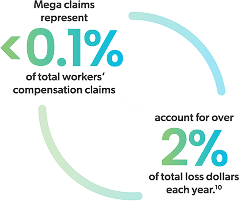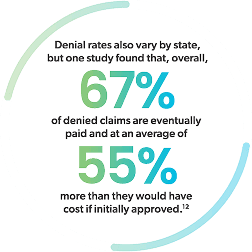Attorney representation is a factor in increasing claim cost and industry stakeholders are concerned that litigation is becoming more common. The reasons injured workers hire attorneys are varied, complex, and many are preventable.
According to the 2025 Annual Workers’ Compensation Industry Insight Survey,1 the most concerning challenge currently facing the industry is litigation. Slightly more than 61% of survey participants cited litigation as the top challenge (a 14 point year-over-year increase), and post-survey interview subjects expressed the belief that a greater portion of injured workers are hiring attorneys, which in turn adds to claim complexity and costs.
Evidence that attorney representation increases claim duration and costs is more than anecdotal. A 2018 study found that attorney involvement increased median claim duration from 305 days for claims without attorney representation to 901 days for claims when an attorney was involved.2 More recently, a 2024 WCRI study of nearly a million claims across 31 states concluded that attorney involvement increases payments by $7,700 to $12,400, increases lost time days by 284% and inflates expense payments by 200%.3
Litigation increases lost time days by 284% and expenses by 200%
Whether or not higher proportions of injured workers are hiring attorneys is less clear, however. The aforementioned WCRI study found that 34% of workers with lost time greater than seven days hired attorneys. A previous 2024 study found that 26% of injured workers were attorney represented,4 as compared to 29% of injured workers in 2020,5 which would indicate a decrease in attorney representation. However, the data used in these, and most studies is usually a few years behind, so it is possible that attorney involvement has increased more recently.
Workers’ compensation litigation trends vary considerably among states due to a complex web of laws, claims processes, industries, population demographics, culture, and other factors that may contribute to the level of attorney involvement. Distinguishing between all those factors to definitively conclude which drive claims litigation is complicated, at best. But reasons commonly cited for attorney involvement generally fall into two categories – attorney incentives and injured worker dissatisfaction.
California and New York are reputed to be highly litigious, lawyer friendly states and they are in the top 10 states for percentage of claims with attorney involvement3 (although neither made the top five). And both states do have a large number of attorneys. But there is no obvious correlation between the number of attorneys and the states that have the most attorney representation. Possibly there is a relationship between attorney involvement and a state’s policy regarding attorney fees, although there is a lot of variation there as well.
Attorneys are more likely to become involved in cases that have disputes and more benefits at stake. For example, 64% of claims with permanent partial disability and/or lump sum payments had attorney representation, as opposed to only 14% of temporary disability claims. The type of injury also influences the likelihood of attorney involvement. A majority 61% of claims with neurologic spine pain were represented by attorneys, as compared to 22% of claims for lacerations and contusions. In addition, employment factors, such as type of industry and employee tenure can make a difference. Workers with ten or more years are less likely to hire attorneys than newer employees and construction industry claims are more likely than clerical/professional industries to have attorney representation.3
WCRI study found these factors associated with attorney involvement:

In addition to the measurable characteristics that are associated with litigation, there are a host of more qualitative reasons that attorneys become involved.
Industry stakeholders who participated in our Annual Workers’ Compensation Industry Insights Survey cited opportunistic attorneys, mega claim settlements, and television ads viewed by recovering injured workers as being responsible for increasing litigation and high awards. In addition to these direct perspectives, many studies point to disputes and other difficulties that injured workers experience as primary culprits.

A previous study from WCRI, based on interviews with thousands of injured workers in 11 different states, found that the three biggest reasons injured workers hire attorneys11are:
Overall, 48% of the injured workers who hired attorneys somewhat or strongly agreed that they feared being fired, while only 13% who did not have this fear hired attorneys. Forty two percent of workers who hired attorneys felt that their supervisors suspected them of faking or exaggerating their injuries, as compared to 15% who did not feel this way. And 46% of workers who hired attorneys believed that their claim had been denied, in contrast to 16% of workers who hired attorneys and did not think their claim had been denied.11

Other reasons that injured workers seek attorney assistance include:
Workers’ comp professionals and injured workers generally agree that the system is difficult to navigate. Injured workers’ unfamiliarity with the workers’ compensation system is consistently cited as a barrier to recovery in our Annual Industry Insights Survey and 58% of participants said so this year.1 In a separate study, we found that 50% of injured workers delayed reporting their injuries due to system complexity and lack of clarity about the process. 13
This reason goes hand-in-hand with the fear of being fired. When injured workers are away from the workplace and do not hear from their managers or other representatives of the organization, they sometimes feel neglected and can imagine the worst. Employers may intend only to be considerate and let the worker rest and heal, but reaching out to check if all is going well with medical care and their recovery can go a long way in making workers feel that they are valued and wanted back at work.
Front-line claims professionals are busy people who may be coordinating care and indemnity benefits for a large number of injured workers. Communicating with each one quickly and personally (i.e. by phone) is often not realistic or efficient. Unfortunately, form letters are frequently ineffective, and injured workers who are anxious about medical care and income replacement become easily frustrated and fearful when information that they need is absent or delayed.
Sometimes a lack of communication is replaced by information and requests coming from multiple sources that are duplicative or appear to conflict. Adjusters and nurse case managers may be asking the same questions that the injured worker already answered for the employer, or information from various stakeholders appears to conflict and it is unclear what the injured workers should do. Navigating the system can feel overwhelming to someone already dealing with an injury or illness and turning it all over to an attorney may seem like the best option.
Depending on the state and employer, injured workers with lost time claims may also lose their employer paid health insurance. And they may not be able to pay for health insurance themselves due to reduced wages. This makes it all the more important to them that their treatment be covered by workers’ compensation insurance and attorney representation may make them feel more secure.
40% of injured workers surveyed by Healthesystems cited denial of a specific treatment and/or sufficient fund allocation to pay for treatment as their #1 reason for hiring at attorney. As noted, belief that a claim has been denied is a top reason for hiring an attorney and denial, or significant delay, of medical treatment that the injured worker believes is necessary can also lead attorney involvement.14
Injured workers who are out of work for any period of time must make do with reduced wages and any delay in receiving indemnity payments increases the challenge of making ends meet. And, although medical providers are prohibited from collecting payments from injured workers for work related care, some providers may still send a bill to the worker, which adds to their stress and belief that they need legal representation.
Workers can be unhappy with their employers and/or supervisors for any number of reasons, many of which are no fault of the employer. It is safe to assume, however, that the unhappy worker blames the employer and has less trust that they will receive fair treatment and adequate coverage. Injured workers who are alienated from their employers are more likely to hire attorneys.
Most injured workers really do want to get well and get back to work. The longer injured workers remain at home, the higher the chances they will experience depression and anxiety, which can exacerbate symptoms and delay recovery. The ability to return to the workplace for at least part of the day and contribute in some way can do wonders for a worker’s wellbeing and improve relations with employers.

Workers’ compensation payers have no control over some key factors associated with attorney involvement. Each state regulates how benefits are administered, and some are more likely to invite attorney involvement. The population density of a state influences the volume of claims that must be processed. The industry, type of injury, and employee tenure of each worker is determined before they are injured. Even a worker’s dislike of a supervisor may be entirely subjective and beyond the employer’s control. Payers can be aware of these claim characteristics, which might help with risk identification, but they cannot control them.
Other drivers of litigated claims may be subject to influence, however. Injured workers who hire attorneys are looking for an advocate to represent their interests. Employers and insurers who make it clear that they are already advocating for the injured workers’ best interests – and take steps to prevent or alleviate fears and frustrations – can reduce the chance of attorney representation.

Show colleagues you care about them enough to have this trusted resource to hand hold them through the entire process...frustration decreases, miscommunication decreases, and then obviously litigation decreases.”
There is no question that litigation is a complicating factor in workers’ comp claims. The reasons that injured workers hire attorneys are also complicated and may be, to some degree, preventable. Examining the characteristics of claims with attorney representation versus those that follow the standard process is an ambitious task that may or may not be worthwhile for individual payers. Looking for ways to optimize care, improve the injured worker experience, and build trust might ultimately achieve a similar result.
